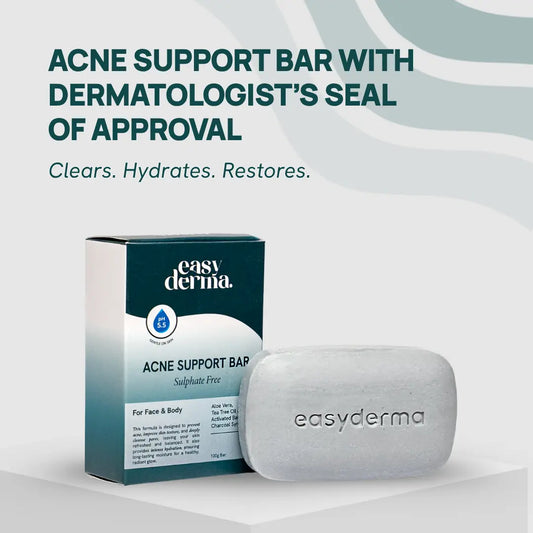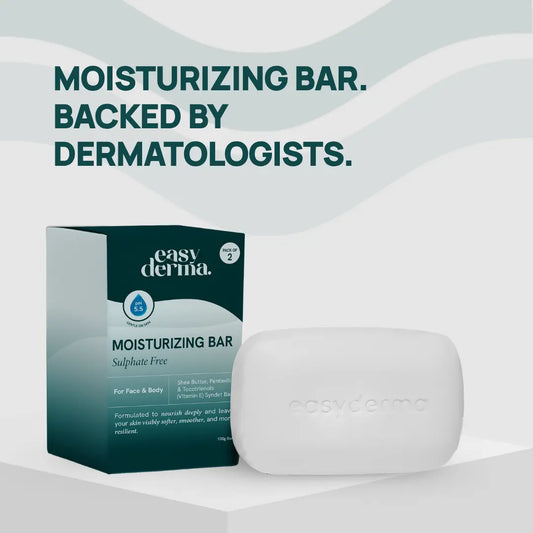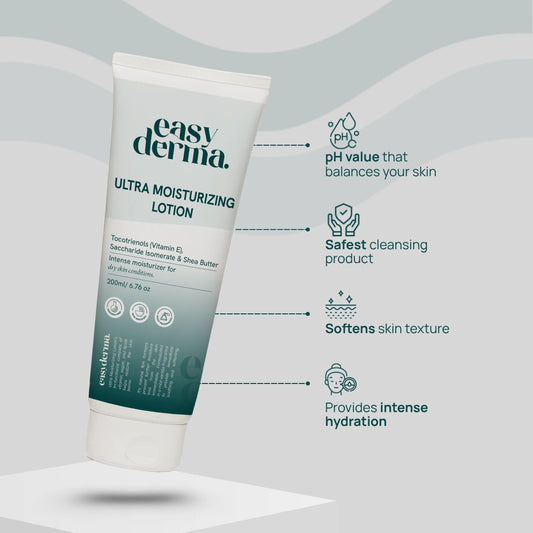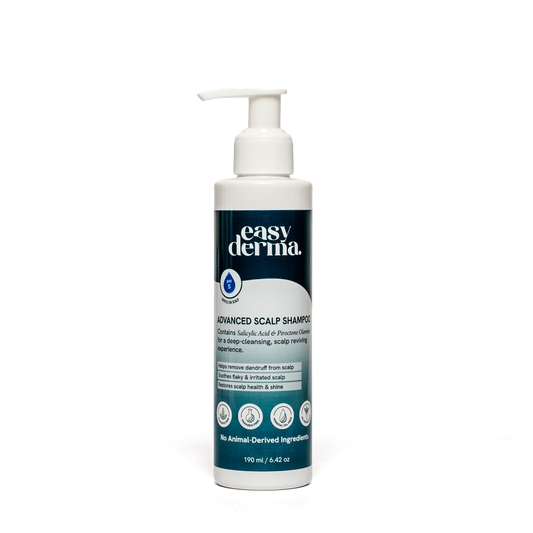What Is Acne?
Acne, commonly known as pimples, occurs when your pores get blocked with excess oil, dead skin cells and bacteria. These clogged pores then become inflamed, leading to red bumps, whiteheads, blackheads or deep painful cysts. Acne is not just a teenage concern—many adults experience breakouts due to lifestyle, hormonal shifts, or environmental triggers.
When your skin’s oil glands produce more sebum than needed, your pores get congested. Add humidity, dirt, sweat, or heavy skincare products to the mix, and breakouts become even more common. Dermatologists recommend using pH-balanced and sulphate-free cleansers, such as the Easyderma Acne Support Bar, to gently clean pores without irritating your skin. Understanding how acne develops is the first step toward treating it effectively.

Who Can Develop Pimples?
Pimples can affect anyone, regardless of gender or age. While acne often begins in puberty due to hormonal fluctuations, it can continue into adulthood—especially if you face stress, pollution, or use products that clog pores. In fact, nearly 80% of people will experience acne at some point in their lives.
Adults may develop acne due to hormonal imbalances, lifestyle habits, high humidity, or even a weakened skin barrier. Women may notice flare-ups during menstrual cycles, pregnancy, or stress-related hormonal changes. Men can also experience persistent acne due to higher oil production.
To reduce breakouts, dermatologists advise switching to a non-comedogenic, dermatologically tested, and sulphate-free formulas like the Easyderma Acne Support Bar that cleanse without stripping moisture. Gentle routines help keep pores clean and skin healthier over time.
What Causes Acne? (Key Triggers You Should Know)
Acne is often triggered by a mix of internal and external factors. Hormonal fluctuations increase sebum (oil) production, which makes pores more likely to get blocked. Environmental elements like pollution, sweat, and humidity worsen this congestion, creating an ideal environment for acne-causing bacteria. Using harsh or sulphate-heavy cleansers can also disrupt your skin barrier, making breakouts more frequent.
Lifestyle habits—including a poor diet, stress, and inconsistent skincare—may also worsen pimples. Heavy makeup, sleeping without washing your face, and pore-clogging products build up over time. Dermatologists recommend switching to pH-balanced, sulphate-free cleansers like the Easyderma Acne Support Bar, which uses Activated Bamboo Charcoal and Tea Tree Oil to gently clarify skin without irritation. Understanding these triggers helps you build a routine that prevents future flare-ups.

Types of Acne (Understanding Your Breakouts)
Acne appears in several forms, each requiring a slightly different approach. Whiteheads and blackheads occur when pores get blocked with oil and dead skin. Papules and pustules are inflamed bumps caused by bacteria and excess sebum. More severe forms, like nodules and cystic acne, develop deeper within the skin and can be painful or leave scars.
Identifying your acne type is essential for choosing the right products. Mild congestion can often be managed with gentle cleansing using the Easyderma Acne Support Bar, which deeply cleanses the pores without stripping natural moisture. For persistent or painful acne, Dermatologists recommend consistent routines that strengthen the skin barrier and reduce inflammation. With the right approach, you can minimize breakouts and support healthier, clearer skin.

How to Treat Acne Safely (Dermatologist-Trusted Approach)
Treating acne requires gentle, consistent care rather than harsh scrubbing or stripping cleansers. Dermatologists recommend starting with a mild, pH-balanced, sulphate-free cleanser to remove excess oil, sweat, and impurities without damaging your skin barrier. The Easyderma Acne Support Bar is formulated with Activated Bamboo Charcoal, Aloe Vera and Tea Tree Oil, offering effective pore cleansing while keeping the skin hydrated and calm.
Follow cleansing with a lightweight moisturizer to maintain barrier strength, as dehydrated skin tends to produce more oil, leading to more breakouts. Avoid popping pimples, over-exfoliating, or using random home remedies, as they can worsen inflammation. When breakouts persist, focus on calming, supportive skincare and avoid products with heavy fragrances or oils. Consistency—not intensity—is key to safely managing acne.

Easyderma’s Supportive Solutions for Acne-Prone Skin
Easyderma offers Dermatologist-Trusted, sulphate-free and pH-balanced formulations designed specifically to support acne-prone and sensitive skin. The Easyderma Acne Support Bar provides gentle daily cleansing using Activated Bamboo Charcoal to clear pores and Tea Tree Oil to reduce surface-level bacteria. This syndet-based bar is mild, non-drying, and ideal for everyday use.
For balanced hydration, pair it with the Ultra Moisturizing Lotion, enriched with Saccharide Isomerate (Vegan HA Booster), Tocotrienols, and Shea Butter, which help maintain moisture without clogging pores. The combination helps soothe inflammation, support barrier repair, and reduce dryness-linked breakouts. Easyderma’s formulations prioritise gentle care, making them suitable even for sensitive or reactive skin types.

Frequently Asked Questions
1. Can daily cleansing reduce acne?
Yes. Using a gentle, sulphate-free, pH-balanced cleanser helps remove excess oil, sweat, and dirt that clog pores. The Easyderma Acne Support Bar is ideal for daily use without irritating the skin.
2. Does oily skin mean I should skip moisturizing?
No. Skipping moisturizer can cause dehydration, leading to even more oil production. Use a lightweight, non-comedogenic moisturizer like the Easyderma Ultra Moisturizing Lotion to maintain hydration.
3. How long does it take for acne to improve?
Typically 3–6 weeks with consistent care. Acne improves gradually, not overnight. Using gentle, supportive products helps maintain long-term results.
4. Can acne be prevented?
While acne cannot be fully prevented, you can significantly reduce flare-ups by cleansing regularly, avoiding pore-clogging products, and maintaining hydration.
5. Are Easyderma products safe for sensitive skin?
Yes. Easyderma formulations are trusted by Dermatologists, are sulphate-free and pH-balanced, making them suitable for sensitive, acne-prone skin.

Conclusion
Managing acne becomes easier when you understand its causes and choose products that support—not strip—your skin barrier. With consistent care rooted in gentle cleansing and balanced hydration, you can minimize breakouts and keep your skin calm and healthier over time. Easyderma’s Dermatologist-Trusted range, including the Acne Support Bar and Ultra Moisturizing Lotion, offers science-backed solutions designed for acne-prone and sensitive skin.
Take the first step toward clearer, calmer skin—
✨ Shop the Easyderma acne care range today.





